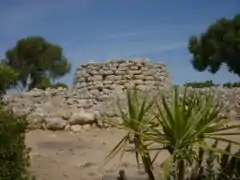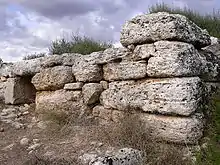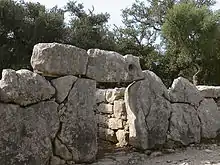Talaiot
A talaiot, or talayot (Catalan pronunciation: [tələˈjɔt]), is a Bronze Age megalith found on the islands of Menorca and Majorca forming part of the Talaiotic Culture or Talaiotic Period. Talaiots date back to the late second millennium and early first millennium BC. There are at least 274 of them, in, near, or related to Talaiotic settlements and the Talaiotic chamber tombs known as navetas. Talaiots pre-date the megalithic structures known as taulas, which are usually found nearby. While some Talaiots are thought to have had a defensive purpose, the use of others is not clearly understood. Some believe them to have served the purpose of lookout or signalling towers, as on Menorca, where they form a network.[1] Talaiots generally take the form of circular or square buildings, and they may have been used as dwellings or meeting places.[2] The talayots on Menorca have been much less prone to weathering than the ones found on Majorca. Despite this, very few grave goods have been found in Menorcan talayots, leading historians to believe that the island had a poorer economy than its larger neighbor.[3]



The first author to write about these structures was Juan Ramis in his book Celtic antiquities on the island of Menorca, which was published in 1818, and was the first book in the Spanish language entirely devoted to prehistory.
There are similar megalithic buildings found in other areas of the Western Mediterranean, though these are not necessarily related to talaiots. Examples include the "nuraghes" of Sardinia, the "torri" of Corsica, and the "sesi" of Pantelleria.
Sites
Talaiotic sites include:
- Capocorb Vell, 12 km south of Llucmajor, Majorca: five talaiots and ancient village
- Ses Païsses, near Artà, Majorca
- Son Oleza dolmen, Majorca, discovered in 1999 [4]
- Bocchoris, Majorca [5][6]
- Settlement at S'illot, Majorca
- Talatí de Dalt, Menorca
- Trebalúger, Menorca, dating from around 1500–100 BC: one of the oldest Talaiots on Menorca[7]
- Trepucó, Menorca
- Torre d'en Galmés, Menorca
Archaeology
In 2019 a well-preserved 3,200-year-old Bronze Age sword was discovered by archaeologists under the leadership of Jaume Deya and Pablo Galera at the Talaiot del Serral de ses Abelles in the Puigpunyent municipality of western Majorca. The archaeologists believe that the weapon was made when the Talaiotic culture was in decline. The sword will be on display at the Majorca Museum.[8]
See also
Sources
- Gomila, Joan J. Menorca: An Architectural Guide
- Quintero, Josephine (2011). DK Eyewitness Travel Guide: Spain. Dorling Kindersley. p. 527. ISBN 9781405348386.
- Garcia, Lluis. "The Talayot Culture in Menorca." The Balearic Islands. London: Thames & Hudson, 1972. 67-74. Print.
- "A 2000 A.D. REVIEW OF 2000 B.C." PAGE2. Web.
- Enciclopedia. Web. <http://www.enciclopedia.cat/fitxa_v2.jsp?NDCHEC=0010635>.
- Ballestero, Elena (6 April 2018). "Bocchoris, patrimonio arqueológico en peligro por los 'vándalos' del siglo XXI" [Bocchoris, archaeological heritage endangered by the 'vandals' of the 21st century]. Ultima Hora (in Spanish).
- Dillon, Paddy (2013). Walking in Menorca. Cicerone Press Limited. p. 41. ISBN 9781783620005.
- Margaritoff, Marco (2019-09-20). "3,200-Year-Old Bronze Age Sword Unearthed On Spanish Island Of Mallorca". All That's Interesting. Retrieved 2019-10-30.
External links
- Megalithic Menorca. Discovering Menorca
- Guide to Menorca: Prehistory Archived 2015-12-16 at the Wayback Machine
- Talayots.es - Comprehensive site for prehistoric monuments in Mallorca and Menorca (in Spanish)